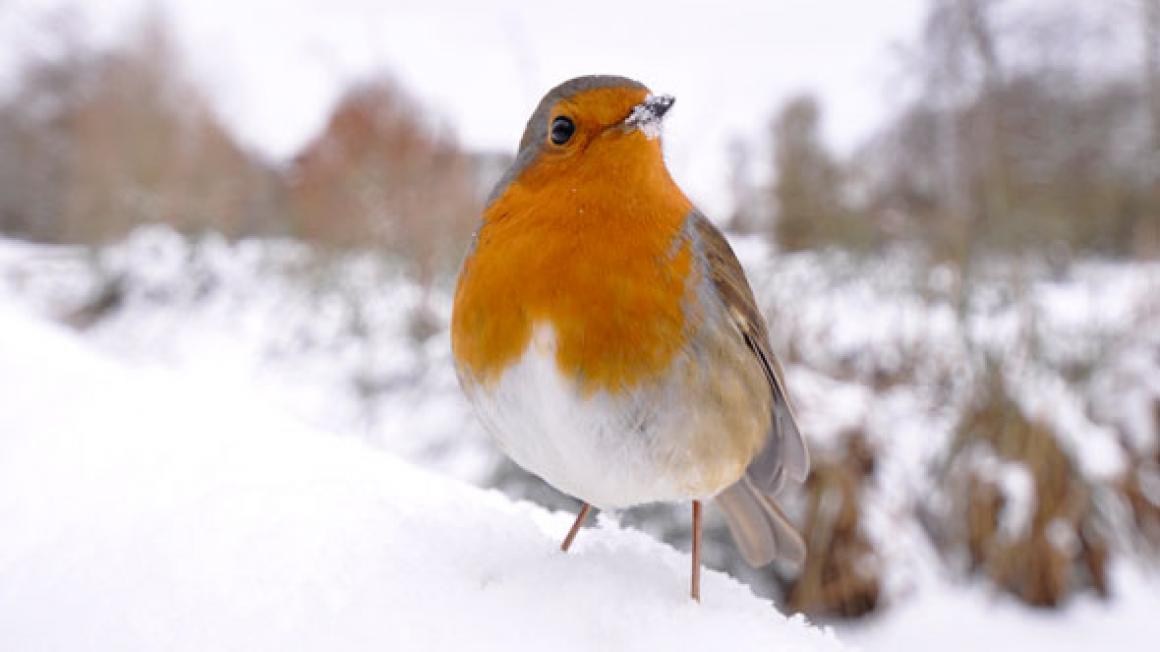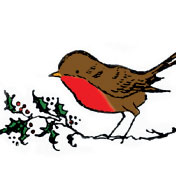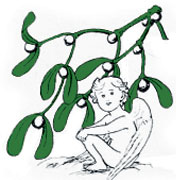HOW THE ROBIN GOT HIS RED BREAST…
BRINGING IN THE YULE LOG
The tradition of burning a huge log at the darkest time of the year, to bring warmth and symbolise the return of the sun, is much older than the Christian festival now associated with it. It was originally a pagan Norse ceremony (Yule is a Norse word). They burned oak logs in honour of their god, Thor and when Christianity arrived in England, the Church fathers did their best to put a Christian stamp on this ancient tradition. They ordained that ash was the most appropriate wood for the Yule log, because baby Jesus was given his first bath in water heated by a fire of ash logs lit by shepherds who, asThe tree that would become the Yule log was chosen long in advance and carefully nurtured. When the time came, it was felled and often decorated with ribbons. The log’s arrival at the house on Christmas Eve was always greeted with a celebratory drink. Whoever lit the log had to wash their hands first, otherwise superstition dictated the log wouldn’t burn properly.
Anyone with a squint wasn’t allowed anywhere near the log, for fear of them bringing bad luck. The same was true for any woman with bare, or flat, feet. Despite these strictures, it was believed the Yule log burnt away the year’s arguments and resentments.
On the Twelfth Night, when all the decorations were removed from the house, the Yule log was extinguished. Whatever remained was carefully stored ready for next Christmas Eve, when it would be used to light the new Yule log.
THE HISTORY OF PANTOMIMES
Pantos have connections with medieval mummers’ plays and with the Italian Commedia dell’arte that arrived in Britain in the 16th century.The Italian productions featured their own characters, such as Harlequin, but most of the Italian actors couldn’t speak much English, so they relied on the sort of comic stage business that we now call slapstick – recognisable in late-18th century characters, such as Jack The Giant Killer (of beanstalk fame).
The first British pantomime proper was Jack And The Beanstalk, performed at the Theatre Royal, Drury Lane, London, in 1819.
ROBIN REDBREAST AND THE NATIVITY
Finally, a small, nondescript brown robin flew over to the fire and fluttered there, fanning the embers with its wings until the flames leapt up again. Then it flew off and returned with twigs in its beak to put on the fire. A spark jumped out of the fire and caught the bird on the chest, turning it red. Mary was so grateful for the little bird’s efforts that she declared it would always have a red breast, symbolising its kind heart.
ROBINS AND REDBREASTS
It is often claimed that postmen were called ‘redbreasts’ because they were seen dashing about with the Christmas mail in their red waistcoats, but this is a myth. The first Royal Mail uniforms, issued for mail-coach guards in 1784, consisted of scarlet coats with blue lapels. The red waistcoats actually belonged to the Bow Street Runners, precursors of the British professional police force.Regardless of who wore the waistcoats, when it became fashionable to send Christmas cards from the 1840s, red-breasted robins became associated with the Christmas post.
KISS, KISS
Fashions come and fashions go, but mistletoe has been an essential element of a happy Christmas for centuries. This must, surely, have something to do with the tradition of kissing beneath it. Mistletoe bunches had to be generous because every time a kiss was claimed, you were supposed to pick off a berry.THE KISSING BOUGH
UNKISSED AND UNMARRIED
It was essential for every unmarried girl to be kissed at least once beneath the mistletoe each Christmas. If she didn’t achieve this, tradition held that she could write off any chance of marching up the aisle in the coming year.However, sleeping with a sprig of mistletoe tucked beneath her pillow was said to make her dream of her future husband, even if she wouldn’t be marrying him any time soon.
LIGHTING-UP TIME
One of the great glories of Christmas trees is their light show… when they work, of course.Our ancestors decorated their trees with candles, originally pinned in place. Later, enterprising manufacturers developed tiny candleholders that clipped on to the tree branches. These were a fantastic idea until you tried to use them – if the candle was too heavy, it listed to one side, dripping hot wax on to lower branches, presents and carpet. And there was always the possibility of setting the tree – and your house – alight.
Strings of electric lights for Christmas trees arrived shortly after Joseph Swan patented the light bulb in Britain in 1880, which was a year after Thomas Edison had secured his own patent in the United States.
 At first, of course, electricity was an expensive luxury for the very few. Edward Hibberd Johnson, one of the lucky (rich) few, decorated his New York Christmas tree with a string of 80 electric lights, in suitably patriotic red, white and blue, in December 1882. He happened to be the vicepresident of the Edison Electric Light Company, which may have had something to do with it.
At first, of course, electricity was an expensive luxury for the very few. Edward Hibberd Johnson, one of the lucky (rich) few, decorated his New York Christmas tree with a string of 80 electric lights, in suitably patriotic red, white and blue, in December 1882. He happened to be the vicepresident of the Edison Electric Light Company, which may have had something to do with it.For the first time, in December 1935, Selfridges was ablaze with light from the illuminated Christmas trees outside its façade. Within a few years, the Second World War intervened with its nightly blackout, when no one was allowed to show a light in case it attracted enemy bombers.
Money was scarce after the war and London’s streets remained unadorned until 1954, when the businesses that made up the Regent Street Association clubbed together and paid for Regent Street to be decorated with strings of Christmas lights. The Oxford Street Association followed Regent Street’s lead in 1959 with its own Christmas lights.
Unfortunately, it seems that recessions come round almost as frequently as Christmas and, in 1967, Oxford Street switched off its Christmas lights because of a lack of funds. Regent Street did the same in 1971 and neither resumed normal Christmas service until 1978. These famous light shows have been going strong, albeit with mixed reviews, ever since.
MINCE PIE ETIQUETTE
 No knives, please
No knives, please Never, ever, cut a mince pie with a knife. You will be courting bad luck in the most foolhardy way. Break it up with a fork or spoon, or simply pick it up and take a big bite.
Make a wish
When you are about to eat the first mince pie of the Christmas season, don’t unthinkingly shove it in your mouth. You must make a wish first.
One a day
Soothsayers from the past advised eating a mince pie on each of the Twelve Days Of Christmas… apparently to guarantee a happy year to come.
Only a fool would refuse
Never refuse a mince pie… It has nothing to do with the fear of offending your host or hostess (even though that might happen), but by saying no, you will be declining good fortune.
Shhh!
Mince pies should always be eaten in silence. This is a rule that is easy to keep if you are eating while desperately trying to remember all the things you should be doing to court good fortune…
The Book Of Christmas: Everything We Once Knew And Loved About Christmastime, by Jane Struthers (Ebury Press, £9.99)





